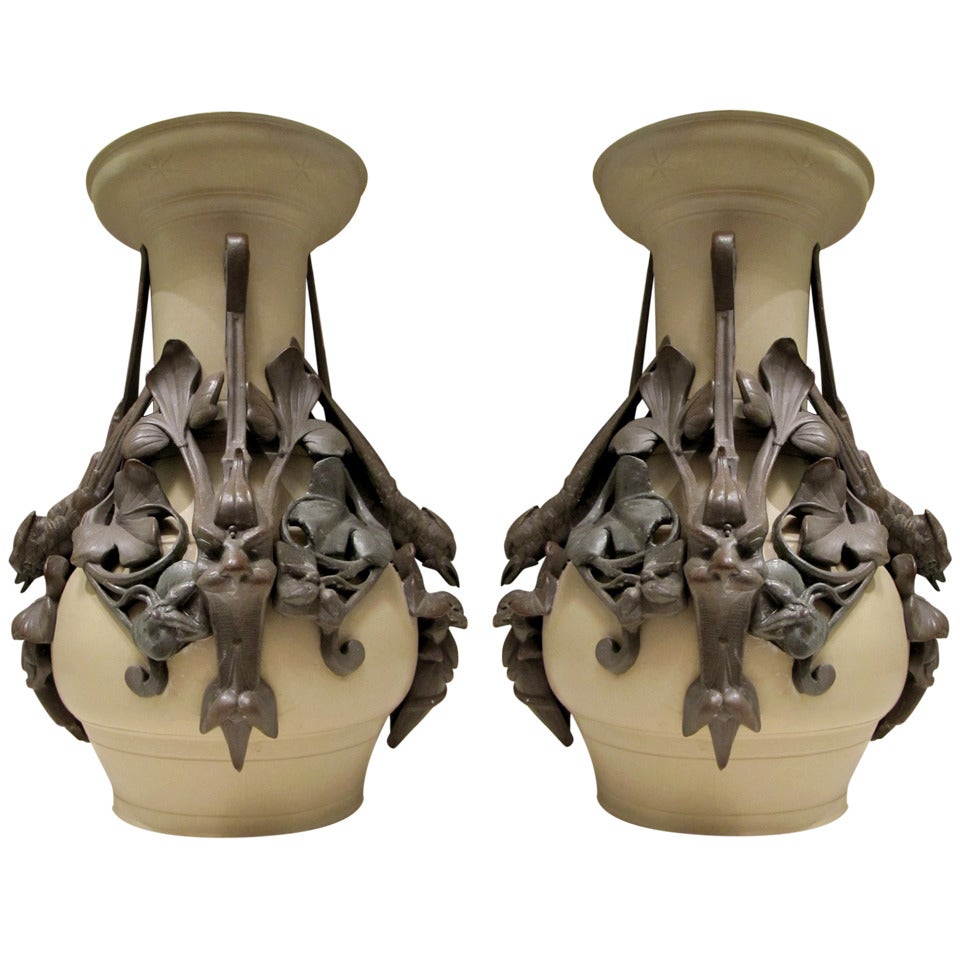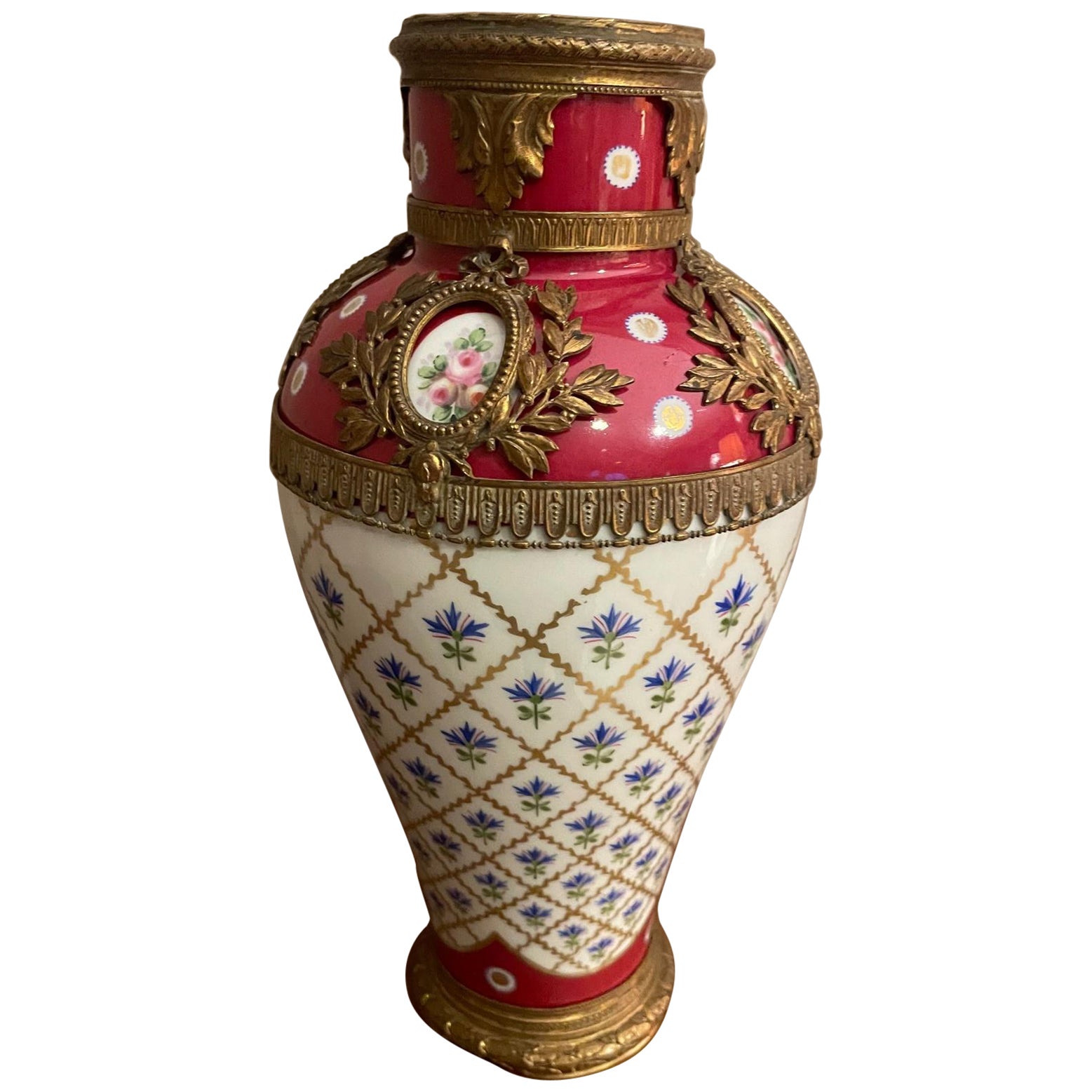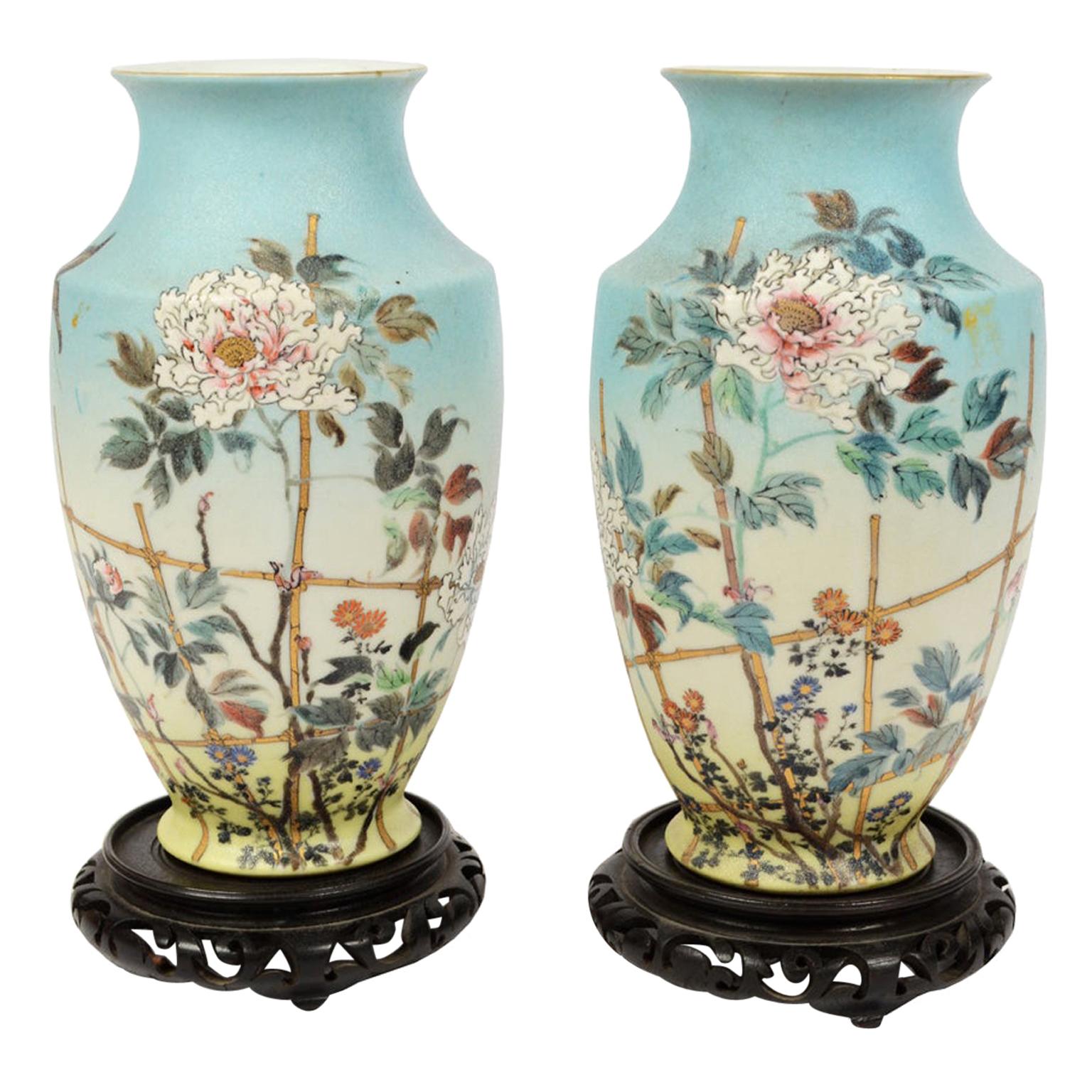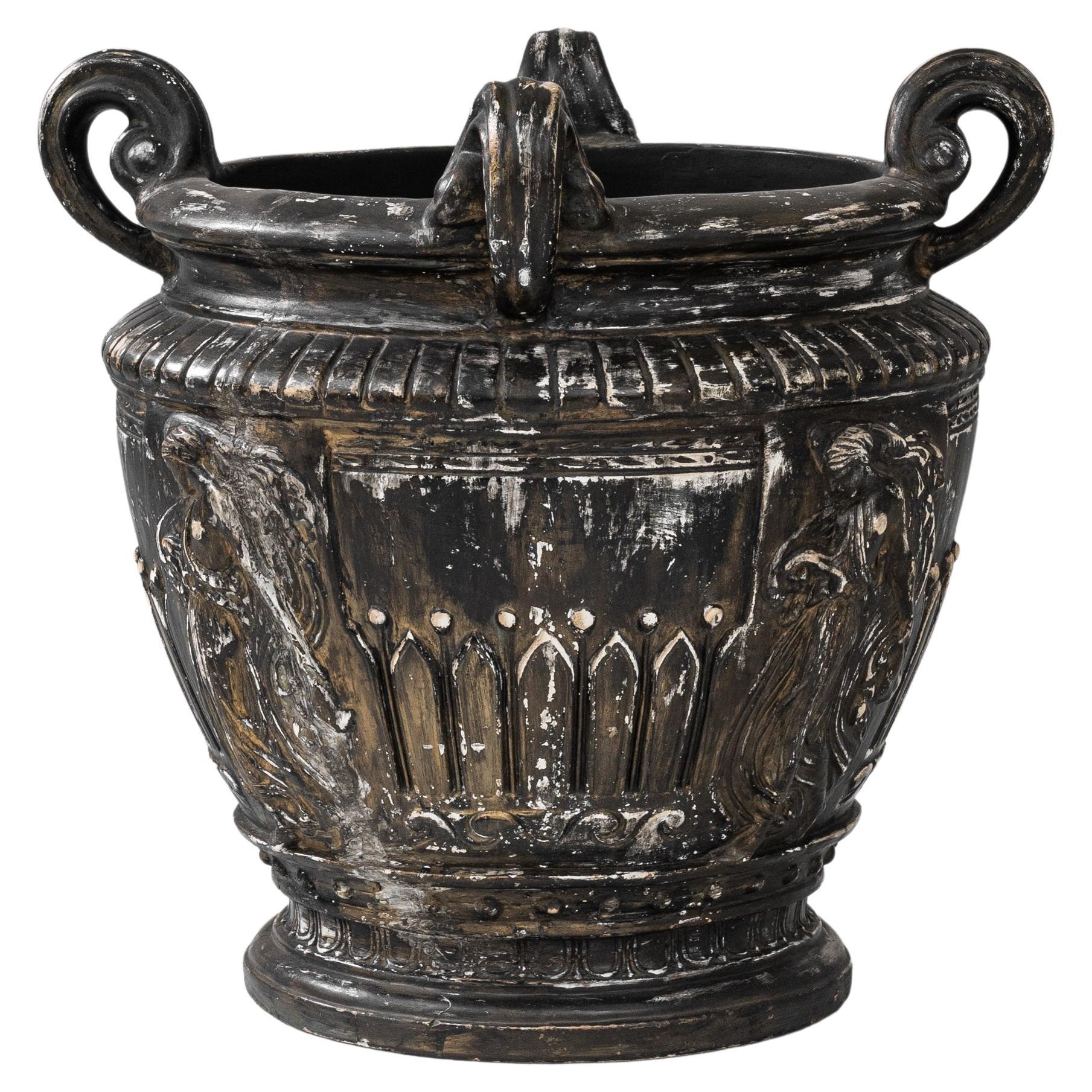Items Similar to Roman Bronze Works, a Pair of Bronze Vases with Nymph and Satyr Relief, 1900s
Want more images or videos?
Request additional images or videos from the seller
1 of 7
Roman Bronze Works, a Pair of Bronze Vases with Nymph and Satyr Relief, 1900s
About the Item
American Renaissance period.
A Pair of Patinated Bronze Vases with Nymph and Satyr Bas-Reliefs by Roman Bronze Works, New York City, circa 1900.
Dimensions:
Height: 16 inches
Width: 5-1/2 inches
Depth: 6-3/4 inches
Roman Bronze Works, now operated as Roman Bronze Studios, is a bronze foundry in New York City. Established in 1897 by Riccardo Bertelli, it was the first American foundry to specialize in the lost-wax bronze casting method, and was the country's pre-eminent art foundry during the American Renaissance (circa 1876-1917).
- Creator:Roman Bronze Works (Maker)
- Dimensions:Height: 16 in (40.64 cm)Width: 5.5 in (13.97 cm)Depth: 6.75 in (17.15 cm)
- Sold As:Set of 2
- Style:American Craftsman (Of the Period)
- Materials and Techniques:Bronze,Patinated
- Place of Origin:
- Period:1900-1909
- Date of Manufacture:1900
- Condition:Wear consistent with age and use. We make our best effort to provide a fair and descriptive condition report. Please examine the photos attentively. Send us a message to request more details or discuss price.
- Seller Location:New York, NY
- Reference Number:1stDibs: LU2819314755551
Roman Bronze Works
Roman Bronze Works, now operated as Roman Bronze Studios, is a bronze foundry in New York City. Established in 1897 by Riccardo Bertelli, it was the first American foundry to specialize in the lost-wax casting method, and was the country's preeminent art foundry during the American Renaissance (1876–1917).
About the Seller
5.0
Vetted Seller
These experienced sellers undergo a comprehensive evaluation by our team of in-house experts.
Established in 1993
1stDibs seller since 2017
68 sales on 1stDibs
Typical response time: 2 hours
- ShippingRetrieving quote...Ships From: New York, NY
- Return PolicyA return for this item may be initiated within 10 days of delivery.
More From This SellerView All
- Charles Vital-Cornu, French Art Nouveau Bronze Sculptural Floral Vase, 1900sBy Charles Vital-CornuLocated in New York, NYCharles Vital-Cornu (French, 1851 - 1927), Jouffroy’s and Pils’ pupil, he acquired a skillfulness mastery in carving marbles and producing bronzes. He used several patinas in his production. Indeed, if his pieces' embodiments are often golden-brown colored, the hollow part are darker. His figures, hands, faces, and bodies are of a great quality. Charles Vital-Cornu had participated in numerous annual ‘‘Salons’’ organized in Paris by ‘‘la Société des Artistes Français’’ where he got several awards, such as a mention of Honor in 1880 and 1881, a third class medal in 1882, a travelling grant in 1883, a second class medal in 1886, a bronze medal at the 1889 World Fair and, finally, a silver medal at the 1900 World Fair at the Grand palace...Category
Antique Early 1900s French Art Nouveau Vases
MaterialsBronze
- French Art Nouveau Iridescent Stoneware & Bronze Vase or Cachepot, ca. 1900sLocated in New York, NYFrench Art Nouveau Ocean Life Theme Vase Cachepot Iridescent Stoneware & Patinated Bronze Crab Appliqué ca. 1900s ABOUT We present here a most unusual and utterly decorative Fren...Category
Antique Early 1900s French Art Nouveau Vases
MaterialsStoneware
- Frederic Rhead, a Pair of Arts & Crafts Terracotta Vases with Peacocks, ca. 1900By Frederick Hurten RheadLocated in New York, NYFrederic Rhead, a pair of English Arts & Crafts Glazed terracotta vases with Peacocks, circa 1900. This outstanding pair of English Arts & Crafts gla...Category
Antique Early 1900s English Arts and Crafts Vases
MaterialsTerracotta
- Japanese Art Nouveau Awaji Ware Art Studio Pottery Flower Vase, ca. 1900sLocated in New York, NYJapanese Art Nouveau Flower Vase Awaji Ware Art Studio Pottery ca. 1900s ABOUT AWAJI WARE ART STUDIO POTTERY Awaji pottery was made on the Japanese island of the same name between...Category
Antique Early 1900s Japanese Art Nouveau Vases
MaterialsPottery
- French Art Nouveau Patinated Bronze Sculptural Iris Vase, ca. 1900Located in New York, NYABOUT IRIS The iris is a special and mysterious flower. Not only because of its striking appearance, but also from an artistic and historical point of view. It is also like a work of art, as though created by Mother Nature. The unique leaves of this plant not only create wonderful shadow casts, but also look as if they were painted by hand. It's no wonder that iris acts as the muse for countless artists, and can be seen in many famous works of art. The iris was first spotted in the time of Pharaoh Thutmose, in 1504 BC. He had the iris inscribed into the wall reliefs of a temple as a sign of his power, as well as decorating his sceptre with motifs of the flower. Since then, the iris has been a symbol of victory in Egypt. But the symbolism of the iris goes further than that. In Japan, the flower represents courage and is the symbol of the boys' festival. In Islamic cultures, the iris is a symbol of prosperity. In Europe, the flower was a popular weapon symbol in the Middle Ages and stood for chivalry. And in Christianity, the iris was seen as a symbol of the trinity because of its three-part flowers. With more than 300 varieties, the iris is now the most popular flower among growers and gardeners following the rose. Countless artists use the iris in their works and the flower is present in all eras. You can see the flower on furniture, vases, jewelry, fabrics, sculptures, coats of arms and much more. Did you know that the iris is also called the sword lily? It's not a coincidence that it used to symbolize physical and emotional pain and suffering caused by a weapon. We also see the flower in religious art, where it's often associated with Mary and Jesus. The iris is also associated with the Greek goddess Iris, where the flower symbolizes reconciliation and divine messages. This is also reflected in many paintings. Finally, the iris is also visible in Dutch and Flemish still-life paintings. This can be in a religious form, incorporated into an object or as a decorative flower. In the Art Nouveau art movement, the iris (along with other plants, such as the birch) was often used as an expression of feminine beauty. With its almost otherworldly appearance, the iris is perfectly suited to the Art Nouveau aesthetic and is featured in many well-known works of art. The poet of that era, Hermann Hesse...Category
Antique Early 1900s French Art Nouveau Planters, Cachepots and Jardinières
MaterialsBronze
- Japanese Art Nouveau Meiji Period Patinated Bronze Vase, circa 1900Located in New York, NYAlthough unmarked, this rare and important, grand but at the same exquisite patinated bronze vase has just a very few little details, defying the shape of the handles, as well as the...Category
Antique Early 1900s Japanese Art Nouveau Vases
MaterialsBronze
You May Also Like
- Rare Pair of 1900s VasesLocated in Paris, FRPair of 1900s vases in glazed stoneware, decorated with hunting birds, insects, leaves and fruit, ribbons and masks of lion. The inside is lined with a container of tinplate.Category
Early 20th Century Unknown Art Nouveau Vases
MaterialsStoneware
- Roman Relief Pottery VaseLocated in Islamabad, PKPottery was an important part of daily living in ancient Rome. As Romans used earthenware for most purposes, a huge quantity of utensils - cooking pots, amphorae and fine wares were ...Category
21st Century and Contemporary Italian Renaissance Vases
MaterialsLimestone, Carrara Marble
- 1900s Pair of Art Nouveau Ceramic Neapolitan VasesBy Guido CacciapuotiLocated in Catania, SiciliaTwo rare Art Nouveau ceramic vases made in Italy in 1900. They depicting two children playing. Signs of use and age visible on the photos.Category
Antique Early 1900s Italian Art Nouveau Vases
MaterialsCeramic
- 20th Century French Bronze and Sevres Porcelain Vase, 1900sBy Manufacture Nationale de SèvresLocated in LEGNY, FRVery nice early 20th century French porcelain vase from the famous Sevres manufacture in the 1900s. Beautiful flowers and golden details. The bronze part is removable. There is als...Category
Antique Early 1900s French Urns
MaterialsBronze
- Early 1900s Pair Antiques Japanese Porcelain Vases with Flowers and ButterfliesLocated in Milan, ITPair of vases made of polychrome porcelain depicting hand-decorated flowers and butterflies, complete with base of carved wood. Japanese manufacture, early 1900s, signed on the base....Category
Early 20th Century Japanese Vases
MaterialsPorcelain, Wood
- Antique Pair of Vases On A Marble Base, France, 1900sLocated in Greven, DESet of so-called side plates . Used to be placed next to clocks on the right and left. Formerly electrified. Cast zinc on marble base.Category
Early 20th Century French Garniture
MaterialsMarble, Zinc
Recently Viewed
View AllMore Ways To Browse
Bronze And Gold Vase
Antique Bronze Vessels
Pair Relief
Pair Of Reliefs
Relief Vase
Bronze Vase Pair
Pair Of Bronze Vases
Pair Bronze Vessels
Pair Craftsman
Patinated Bronze Vase
Pair Of Vases 1900
Craftsman Period
New Pair Of Vases
Antique Roman Vase
Roman Bronze Pair
Roman Relief
Gold Relief Vase
Antique Furniture Pre 1900






